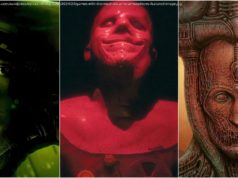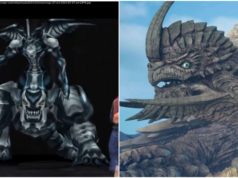Developer Micah McGonigal talks about the design and development of his edutainment horror game Baldi’s Basics, in the process reminding us how weird
“The most important thing I wanted to capture with the game was an unsettling feeling of things being off,” says Micah McGonigal, developer of edutainment/horror mixture Baldi’s Basics in Education and Learning.
“I didn’t want to go flat-out horror; I just wanted to create a mish-mash of different things that don’t quite meld together right, but also don’t seem ridiculously over-the-top and crazy.”
Baldi’s Basics begins innocuously enough, tasking players with finding notebooks and solving trivia questions within a crude, explorable 3D world.
As players fail questions and wander, though, a sense of unease permeates events and meetings, one created by the visuals being purposely made to look a little bit ‘off’, not unlike many past educational games the developer has seen or played.
McGonigal draws upon accidentally-unsettling visual elements of old educational games to create a disturbing world in Baldi’s Basics, and in doing so creates unease from a general sense of something being wrong, and not so much from a frightening creature stalking the player. The game’s balding antagonist is far from terrifying, but through the game’s visual design, McGonigal harnesses unease to make the player feel dread even if they cannot pinpoint a reason why they feel that fear. By making things look ‘off’, he can create fear before the player even knows what they should be scared of.
By moving away from monsters and dark halls and into places that simply don’t feel right, the developer can also open up horror to people who might not find it tolerable, opening the genre up to new audiences.
“The main inspiration for Baldi’s Basics is pretty much Sonic’s Schoolhouse. I never played it growing up, but when I first saw it, I was immediately creeped out by it, and that was pretty much where the idea came from,” says McGonigal.
Baldi’s Basics doesn’t immediately strike fear into the player’s heart. There’s nothing especially frightening about the school halls or the man who wants to help you with your addition. Similarly, most of the educational games that inspired the game aren’t exactly terrifying all on their own, either, but through small visual elements that conflict with one another, they create a discomfort in the player.
This particular unease was created through McGonigal’s experience and research into educational games and the many accidentally frightening elements within them. “I don’t believe there’s any one game that scared me when I was little, but I do know there were plenty of different things in different games that gave me the creeps,” says McGonigal. “One thing that was common in a lot of edutainment games that always creeped me out was the sort of uncanny CG graphics they would use. It was pretty cheap looking, but not too cheap looking. The characters and animated stuff were also often 2D, which made the CG stuff look even more out of place.”
Mixing two visual styles was one way that some of these past educational games would accidentally create unease, mainly done through these conflicting, inconsistent art styles. By not sticking to any one particular look, it would dredge up this sense that something was wrong, even if it may only be the fact that the art style don’t look right together at all.
“A good example would be Reading Blaster Jr. Most of the scenery was CG, and I specifically remember this one game where you could collect these toys, and they always gave me the creeps… Hold on, now I gotta go look it up… Oh great, that’s gonna haunt my dreams for a bit I think,” he continues.
Beyond the conflict between the two art styles, there is a crudeness to the visuals of the toys in Reading Blaster Jr. In one minigame, there are animals and objects within the scene that are in 3D, with these contrasted against the animated characters who also appear. The 2D animated characters move and shift their eyes, but the 3D animated ones stand utterly still, eyes unmoving and unblinking. The juxtaposition of the two styles, however accidental, makes the 3D characters feel unnerving in their stillness.
“I also remember one time at the library there was a Reader Rabbit game on one of the computers, and Reader Rabbit was just standing there, his normal 2D self, when “The Itsy Bitsy Spider” started playing or something, and he started doing the hand motions…except his hands weren’t 2D. They were CG. It pretty much freaked me out [laughs].” says McGonigal.
“That one element definitely influenced Baldi’s Basics art style in a lot of ways. Obviously, Baldi and some other characters are CG, though they don’t quite capture that uncanny look I was talking about. Still, the sort of creepy, uneasy feeling those elements give me is the same feeling I was shooting for in the game,” he continues.
That inconsistency in art style seems to be key to create a revulsion in the player, one that makes the player wish to remove themselves from the play space, not unlike the fear that drives them to flee a lethal monster. It’s a sense that something is very wrong with this place, if only from the jarring differences in art style. This is put to work in the game through varied art styles for objects and characters, the game refusing to settle on one concrete visual design for everything. It creates a sense that the world isn’t put together right, developing that important unease in the player.
“The main inspiration for Baldi’s Basics was old 3D games – the kind with billboarding sprites that slide around, low resolution textures, and maze-like levels that are easy to get lost in. The most important thing I wanted to capture in trying to mimic this style was probably the ‘off’ feeling the cheaper 3D games often gave,” says McGonigal.
“There’s an old game I’ve seen footage of called 3D Dinosaur: Save the Dinosaurs, where you have to wander around a 3D map finding dinosaurs or something. Anyways, that game has a graphics style similar to Baldi’s Basics in a lot of ways. For example, it’s incredibly inconsistent. You’ve got wall and floor textures that vary from solid colors to photo realistic. There are billboarding, photo-realistic bugs and dinosaurs, but then cartoony portraits of dinosaurs on the wall. The inconsistency in graphics style and the low quality of it all makes the game just feel off and unsettling, at least to me,” he continues.
“Another game that inspired the look I was going for is The Museum of Anything Goes,” says McGonigal. “That game is all pre-rendered, but it has exactly the sort of ‘off’ feeling I wanted to capture. In the game, you basically just walk through an art museum. It seems empty, but every screen tends to have some sort of person or thing come on screen and do something… something really weird, usually. You can look into paintings and interact with them, and these often also have really creepy things. Bad CG, low quality audio, strange videos… None if it feels cohesive or makes any sense, but at the same time it’s not ridiculous or over the top.”
McGonigal does nothing to draw attention to the purposeful inconsistencies in the art style. It is simply left to exist, letting the player soak it all in as part of a coherent universe, but one that, again, isn’t put together quite right. It is built in this way to subtly create discomfort, moving through this world whose visual design and characters just look ‘unnatural’ despite being natural inhabitants of this bizarre space. It conflicts to the eyes, and loads Baldi’s Basics with menace.
“Funnily enough, Baldi was picked as the teacher pretty much randomly. He’s actually a character I made up years ago for a comic I wanted to do (There were like, 10 strips total. It didn’t last long.). The idea for Baldi’s Basics was also one I’ve had for a long time, so I don’t remember why I chose Baldi to be the main character. As long as I can remember, the idea had Baldi as the main character and the name Baldi’s Basics in Education and Learning. Still, if I hadn’t already had a character in mind when I went to make the game for the Meta Game Jam, I probably would have gone for Baldi anyways, or at least something similar,” says McGonigal.
McGonigal couldn’t have an over-the-top villain in Baldi’s Basics, as it would break the careful unease he’d created with the conflicting art styles. Also, in keeping with the educational game examples, it would just have to feel frightening without going for outright scares. It was about discomfort, not terror.
“I think the most important thing I wanted to get right about Baldi in the game was making him unsettling, but not necessarily terrifying. Once he starts chasing you, I could have made him have this huge frown, given him pitch black eyes, or, I don’t know, given him a knife instead of a ruler or something.






